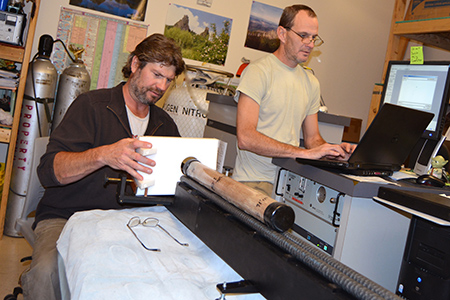November 24, 2014

Photo Margaret McKinney/Highlands University
Highlands geology professor Michael Petronis, left, and geology senior Darren Lemen collect magnetic data from the High Plains Aquifer using the new automated core analysis system in the university’s state-of-the-art paleomagnetic lab.
Las Vegas, N.M. – A Highlands University geology professor’s research will produce the first subsurface geologic map of the High Plains Aquifer, providing vital information for future water management in this aquifer that supplies nearly 30 percent of the groundwater in the United States.
Historic declines in water levels in the nine-state High Plains Aquifer, which includes New Mexico, have created growing concerns about the aquifer’s long-term sustainability.
“Groundwater is a finite resource,” said geology professor Michael Petronis. “The goal of our research on the High Plains Aquifer in western Kansas is to model groundwater flow, giving state and local agencies information to manage water resources more effectively in a sustainable manner.”
In 2011, Petronis secured a $333,461 National Science Foundation grant to study the aquifer in collaboration with the Kansas Geological Society.
Since 2008, the NSF has also awarded more than $900,000 in grants to Highlands to acquire instrumentation for its state-of-the-art Paleomagnetic–Rock Magnetic Laboratory, the only research lab of its kind in New Mexico.
A new instrument acquired for the lab this year is part of the aquifer research.
“This automated core analysis system complements our existing lab equipment and allows us to rapidly and precisely measure the magnetic properties of one-meter sedimentary and rock cores samples,” said Petronis, who directs the paleomagnetic lab. “We are offering world class research opportunities to our students in this lab that helps prepare them for advanced academic studies and high-paying careers in the geoscience field.”
Highlands is now the only geology research facility in the southwest with an automated core analysis system.
Paleomagnetism studies the history of the earth’s magnetic fields recorded in rocks, with applications for studying modern and ancient earthquake patterns and volcanic activity, as well as pressing environmental concerns like climate change.
Geology senior Darren Lemen is analyzing sediment core samples taken from the High Plains Aquifer study area.
“It’s been a great opportunity to work with cutting-edge instruments in the paleomagnetic lab with Dr. Petronis, who is an internationally known expert in paleomagnetic research,” Lemen said. “What I find most fascinating is how paleomagnetic research helps solidify the theory of plate tectonics and how continents shift over time.”
Since 2008, Petronis and his students have used the paleomagnetic lab for 23 research studies published in the Journal of Geophysical Research, Journal of the Geological Society, and Bulletin of Volcanology, to name a few. Petronis and fellow geology professor Jennifer Lindline’s students were lead authors on 10 0f these studies.
The palecomagnetic lab research has also generated more than 70 conference abstracts, most authored by students.
“The research being conducted in the lab allows us to understand both ancient and recent climatic changes as well as volcanic and earthquake activities in the past and present,” Petronis said. “The study areas range from the Las Vegas area to the Czech Republic, Poland and France, as well as eastern Greenland and Svalbard, Norway – both in the northern Arctic Circle.”
Highlands University students have been involved in the geological fieldwork for a number of these research sites.
Petronis said another benefit of Highlands University’s paleomagnetic research capacity is the national and international research collaborations it fosters.
“We are collaborating with the University of North Carolina, University of New Mexico, New Mexico State University, Northern Arizona University and Kansas Geological Survey, as well as several European universities. These partnerships raise the profile of Highlands in the global geologic research community,” Petronis said.
Approximately $100,000 to purchase equipment for the paleomagnetic lab at Highlands came from the National Geographic Society and Highlands University research funds.
